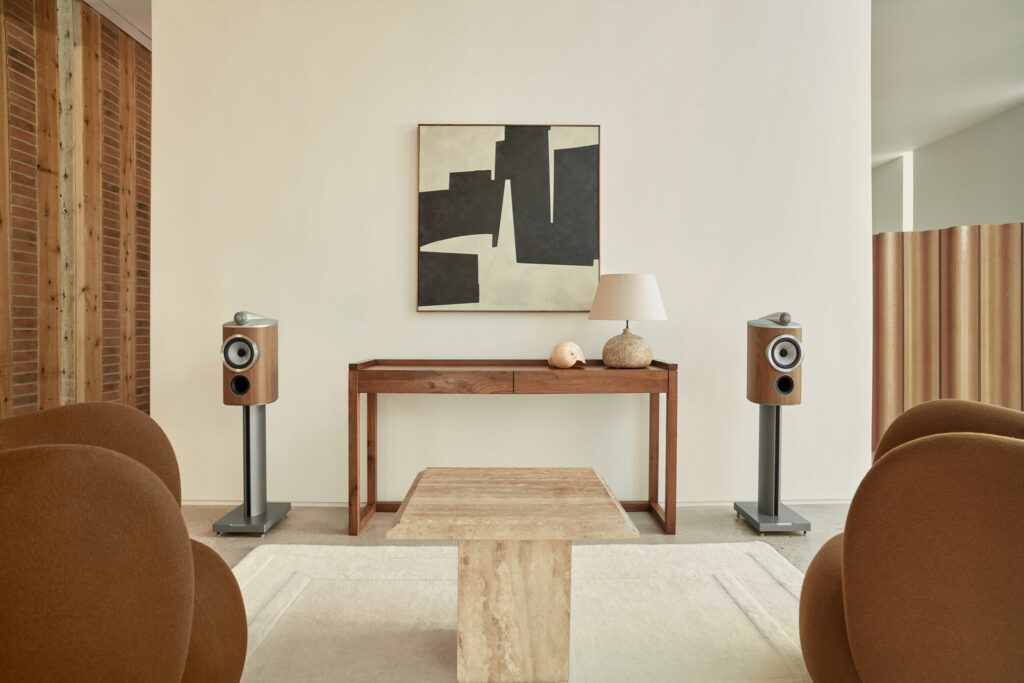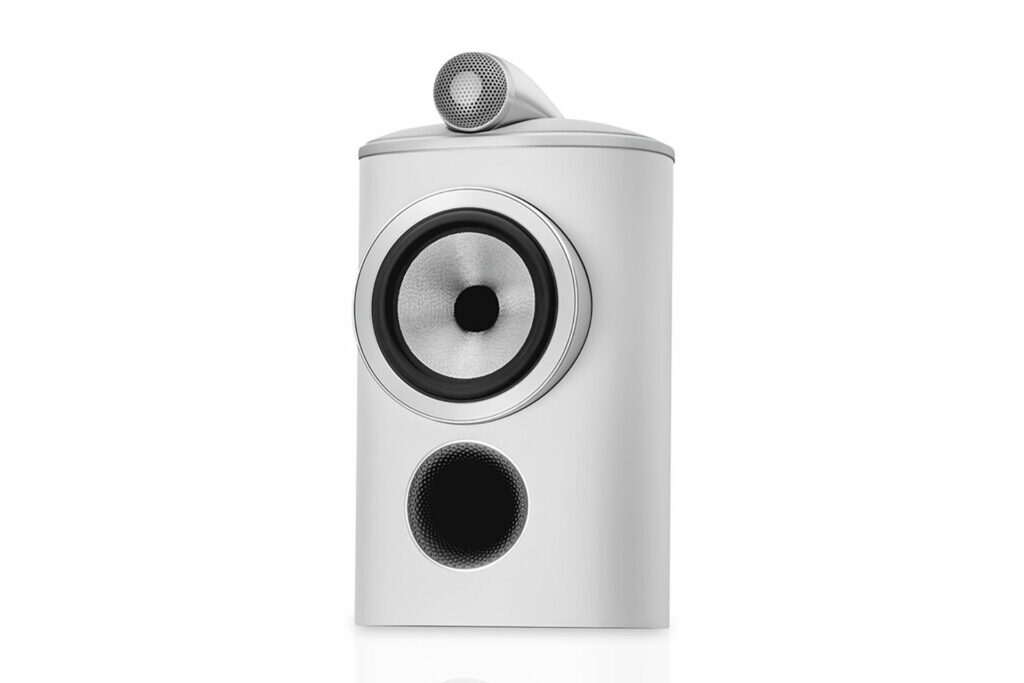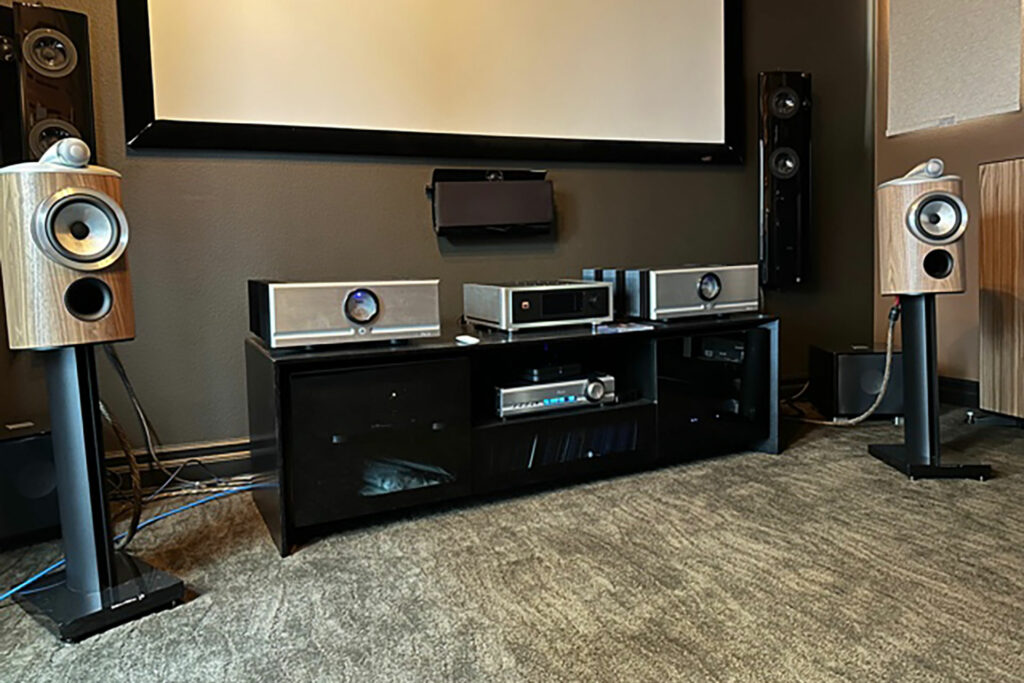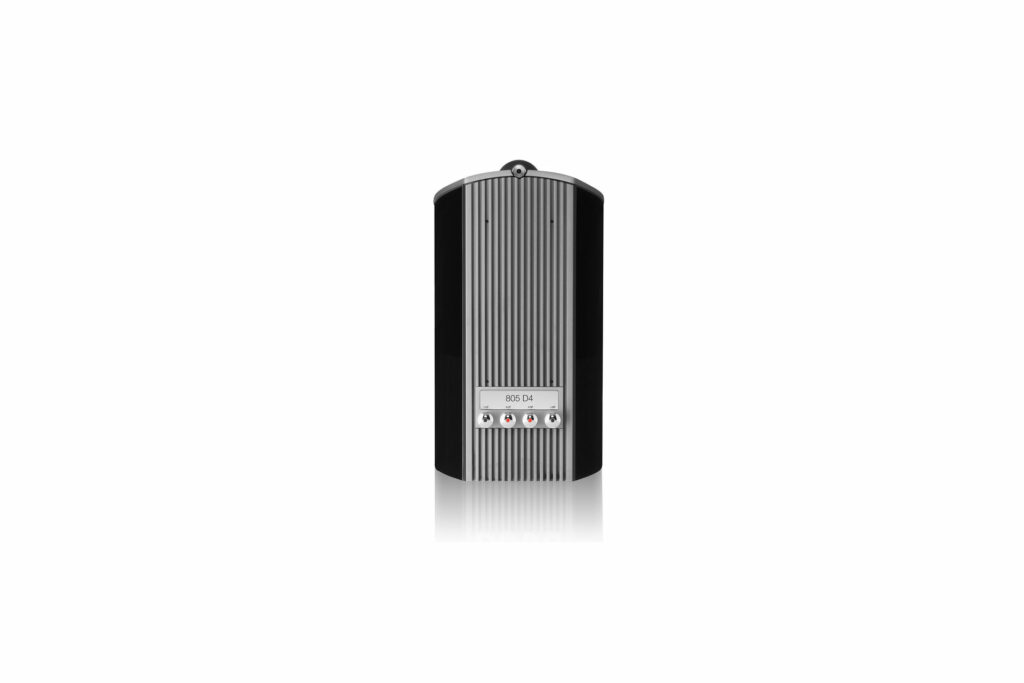The Bowers & Wilkins 805 D4 is the latest version of the British audiophile speaker company’s top-of-the-line stand mounted, two-way, front-ported loudspeaker, priced at $8,500 per pair. Two-way stand mount monitors have an audiophile fanbase since they benefit from diminutive and often stiffer cabinets, with a particular imaging quality and a more coherent transition from tweeter to midrange driver. The Bowers & Wilkins 805 D4 follows this form factor, with specific natural characteristics their floorstanding bigger brothers may not offer.
With over 100 engineers currently on staff, Bowers & Wilkins is a company that never stops trying to find the next level of performance. Its long-standing relationships with iconic studios such as Abbey Road and Skywalker Ranch have yielded not just pro audio speaker credibility but sonic input from some of the best engineers, producers, and artists in the world. Oftentimes, these latest performance bumps come in the form of a Signature Series release, of which there is currently one of for the 805s, which are priced higher at $12,000 per pair. Today’s standard Bowers & Wilkins 805 loudspeakers, the topic of this review, represent a huge performance increase, especially in the high frequencies, over even the most recent version of the 800 Series speakers. How do the smallest and least expensive speakers in Bowers & Wilkins 800 Series stack up in the highly competitive market around $10,000 for smaller, reference monitor bookshelf speakers? Read on.

What Makes the Bowers & Wilkins 805 D4 Speaker So Special?
- The 805 D4 is heavily braced internally with an interlocking birch plywood skeletal structure that creates separate compartments within the enclosure to control energy and vibration, which Bowers & Wilkins refers to as a matrix. Additionally, a front metal plate that runs top to bottom within the cabinet holds a 6.5-inch Continuum mid-bass driver while further strengthening the enclosure. A molded aluminum top plate is an integral part of the cabinet while supporting the separate solid aluminum tweeter enclosure. Lastly, and distinct for the D4 generation, the back panel has an aluminum spine that again increases structure strength but also creates a cavity or for the crossover network, separating it from the internal mechanics of the speaker. The aluminum spine also acts as a heat sink for the crossover network. Needless to say, these are very well-built, highly engineered speakers.
- The separate tweeter enclosure is a tube milled from a solid piece of cylindrical aluminum. This tweeter section is now longer than its previous D3 version, decreasing back pressure. It varies in color from black to raw aluminum, depending on the finish of the cabinet on the speaker itself. Past generations of the Bowers & Wilkins 800 Series yielded a tweeter with a clinically detailed sound that is now gone.
- The fit and finish of the 805 D4 (and the entire 800 Series of speakers) is simply exquisite. American Walnut thus a Satin Walnut (lighter wood finish) and Rosenut (darker) wood finished speakers use book-matched veneer on both right and left units and travel through the manufacturing process together. Gloss black and satin white finished speakers require multiple coats of paint and copious amounts of intense robot sanding of their glorious paint job. Coordinating luxurious light grey or black leather accent tops are part of the style. The sample I received came in a beautiful walnut finish with a light grey leather top. The whole ensemble is simply gorgeous. Magnetic speaker grills that cover the midrange driver are included, but I prefer the look when removed.
- The 805 D4 isn’t hard to drive by modern audiophile speaker standards. Like any revealing loudspeaker, it will definitely benefit from quality amplification, though a modest but well-made amplifier will absolutely work. In the past, the Bowers & Wilkins 800 Series had a somewhat thin high frequency sound especially when powered by lesser amplifiers, but that is just not the case anymore.

Why Should You Care About the Bowers & Wilkins 805 D4 Speakers?
The 805 D4 is for an advanced audiophile who wants the best imaging he or she can afford but possibly might not have space for a full-sized floorstanding audiophile loudspeakers. Adding a mid- to higher-end audiophile subwoofer is an easy solution to make these speakers fit into your listening room while delivering studio quality sound, often from tight spaces. At places like Abbey Road Studios, the Bowers & Wilkins 805s can sit on top of the mixing console just speaker shaming any thought of puny-ass Yamaha monitors. These are serious, world-class speakers even if they aren’t physically huge.
I raved about the fit and finish of the Bowers & Wilkins 805s, as they come in gorgeous wood finishes, come wrapped in sumptuous leather, and are even robot-sanded with 2,000 and then 3,000 grit sandpaper to get a better-than-automotive finish before being painted any number of stock colors. The Signature 800 Series speakers come in a stunning blue paint job, but if you want to match your Bowers & Wilkins 805s to your 2001 Fly Yellow Lamborghini Murcielago, they can do that too. It comes at an additional cost and requires some extra time, but the world is your oyster when it comes to a high performance, luxury product like 805s.

Some Things You Might Not Like About the Bowers & Wilkins 805 D4
- The 805 D4 will require stands in nearly all applications. You could theoretically place them on top of an equipment rack or media console, but that would almost always be a mistake. Forget about placing them on bookshelf – the Bowers & Wilkins 805 D4 are likely too big and/or heavy. Bowers & Wilkins offers a stand designed specifically for the 805 D4, which the company included with my review samples, but they are $1,400 and four to six inches too short, in my opinion. However, they are model-specific custom-made to the 805 D4, designed to bolt through the stand’s base plate into the bottom of the speakers’ threaded inserts. The factory stands are beautiful and come in two color choices – silver or black – and thankfully incorporate cable management. There are several considerably lower priced, universal stand options but with a speaker of this caliber, I am not sure that this is the best strategy unless there is a unique benefit for the installation in your listening room.
- If deep and low, high-output bass is your thing, you may want to look elsewhere or move up in the 800 Series product line. An even better idea is to add a subwoofer or two to your audiophile system setup. The Bowers & Wilkins 805s have very tight, accurate, and pretty low bass but they just aren’t large enough to rock the house with big volumes of bass output. Subwoofers solve this issue obviously, as would making a move to say a pair of Bowers & Wilkins 804 speakers, which are floorstanders and don’t need stands.
Listening to the Bowers & Wilkins 805 D4 Loudspeakers…
During my audition period, the 805 D4 was driven by a pair of Pass Labs XA60.8 monoblock power amplifiers (reviewed), while a Pass Labs XP-12 preamplifier (reviewed) connected a Bluesound Node music streamer to the party. All equipment was connected with WireWorld Electra power cables and WireWorld Eclipse 8 interconnect and speaker cables.
The single-track release, “Crazy” by Alicia Creti, was a good starting point since it is a modern recording that is natural sounding without a lot of obvious processing. The soundstage was vast, almost sounding if it was reaching a full 180 degrees. Imaging was excellent, positioning Creti’s voice in the center, with instrumentation I could discern to her right, left, and behind her with precision. The image levitated in the room – not too forward or relaxed – creating a presentation that kept me interested yet not fatigued. The overall image size and coherence projected by the 805 D4 was impressive, leaving me with a psychoacoustic controversy wrestling in my mind about how it was possible. Creti’s voice had a lifelike quality, displaying texture and her natural, unique, dry vocal timbre. Bass response was focused and detailed sounding, too. The 805 D4 reports a low frequency response of 42Hz, which I would say is accurate, but admittedly, I tend to prefer the lower range down to 35Hz or even a little lower, depending on what I am listening to. On this track, I felt it had more going on in the bottom end in the way of electronic synthesizers or the like, but it was hard to tell. I added in a pair of REL T/7x subwoofers, which made the difference I was looking for. With the subwoofers engaged, the image size became grander: It flourished with deeper bass extension comparable to a pair of accomplished full-range floorstanding speakers, while retaining the unique quality and coherence of a two-way monitor.
I moved on to the song “Blow” on Ed Sheeran’s No. 6 Collaborations Project, with Chris Stapleton and Bruno Mars contributing to the mayhem on this heavy rock track. The presentation was clean and articulate. Again, clarity is a feeling I walked away with. All artists on this track belt it out AC/DC style, yet the vocals did not display a screeching quality. They were detailed and completely enjoyable. Imaging continued to be vivid and easily identifiable with an elegant forwardness without any meaningful fatigue. The Bowers & Wilkins 805 D4 takes you a step further into the realism of the live recording or event, with the higher frequencies having an air of confidence without the etched and analytical characteristics of prior generation 800 Series speakers. The 805 D4 benefited on this track with the pair of REL T/7x subwoofers engaged, extending bass response with a larger, all-out soundstage.
For those who like acoustic instrument artists or tracks that play within a more moderate frequency response range, I played the song “Tennessee Whisky” by Chris Stapleton. It does not play as deep in the lower frequencies as the two prior tracks, yet the 805 D4s continued to excel with the same traits identified above. In a direct A/B test with the REL subwoofers off and on, I could still tell that subwoofers were adding something, but, on this track, it did not lend any real benefit. So, if your music style is generally in that 50Hz range on the lower end, the 805 D4s will be all you likely will need.
Will the Bowers & Wilkins 805 D4 Speakers Hold Their Value?
With the Bowers & Wilkins 800 Series legacy, any pair of 805 D4s will likely be strong in the resale department both now as well as years into the future. I don’t see the value of any modern 805s plummeting like some lesser-known yet also-pricey audiophile speaker products might experience.
Home theater enthusiasts who have Bowers & Wilkins speakers as their mains might swipe up a pair of used 805s for effect speakers. Then again, when was the last time that you saw a pair of current Bowers & Wilkins 805 speakers on the used market? It has been a while for me. Your audiophile investment is going to be safe here.

What is the Competition for the Bowers & Wilkins 805 D4 Speakers?
The Totem Element Fire V2 is priced at $8,450 per pair without stands. The Element Fire V2 is a two-way, sealed-box speaker that utilizes custom drivers and a unique crossover applied to the tweeter, allowing the midrange driver to run up its entire frequency range. The published bass extension is a surprising 30 Hz. The sensitivity is 88dB, the same as the 805 D4.
The Focal Kanta No. 1 retails for $7,998 per pair without stands. It’s a rear-ported two-way design with a frequency response of 46Hz to 40kHz. Focal’s in-house beryllium tweeter and flax cone mid-bass driver complete the design. Sensitivity comes in at a familiar 88dB. The finish on the Focals is different but very slick in its own right.
Another Focal speaker to consider is the Sopra No. 1, priced at $11,998 per pair without stands.This model takes performance up a notch from the Kanta No. 1 in price, performance, and overall refinement. Its version of the Focal beryllium tweeter and W cone material performance is all around better than the Kanta No. 1 but at a higher price, obviously. Frequency response is 45Hz to 40kHz with a sensitivity of 89dB. The Focal Sopra No. 1 speakers are likely a more direct comparison to the Bowers & Wilkins 805s than the Kanta speakers, which are priced more comparably.
The Magico A1 retails for $9,800 with grills but without stands. It sports an all-aluminum sealed box enclosure, beryllium dome tweeter, and carbon Nanographene cone on the midrange driver. Frequency response is 35Hz to 50kHz. The sensitivity is 84dB, which suggests it would benefit from substantial high-powered amplification.
The Joseph Audio Pulsar Graphene retails for $9,995 without stands. Joseph Audio prides itself on its Infinite Slope Parallel Asymmetrical crossover design, which is individually calibrated with precision to match each speaker perfectly. Its 8-ohm nominal impedance creates less demand on an amplifier. Frequency response is 42Hz to 20kHz and is very linear, with a 2dB-plus-or-minus deviance. Sensitivity is not published, unfortunately. The enclosure is a sealed box design.

Final Thoughts on the Bowers & Wilkins 805 D4 Monitor Speakers
The Bowers & Wilkins 805 D4 is a foundational speaker that could be the last speaker you ever need. The speakers’ concise focus combined with clarity and natural detail imaged beyond their size while conveying a convincing quality that is hard to believe but readily accepted. One takeaway from my time with the 805 D4 is when combined with high quality subwoofers that are carefully adjusted, one can create an incredibly unique and over-the-top system that has the benefits of more prominent floorstanding speakers with the qualities of a sophisticated two-way monitor. On that note, you can start with the Bowers & Wilkins 805 D4 and, over time, determine if their bass output is acceptable for your tastes and room. If you need more, high-performance subwoofers are an easy add. If fantastic small speakers are in your future, be sure to audition the Bowers & Wilkins 805 D4. It will be time well invested.




I listened to these speakers when shopping for new speakers. They were bright and harsh and definitely require a subwoofer. Ear fatigue as well
It’s funny, many of the speakers that are reviewed to be bright, I seem to prefer. I also know that over the many *many years of heavy metal and duck hunting, my hearing isn’t what it once was.
I’m listening to their little brothers, 705S3 I bought brand new (with a pair of SVS SB-3000’s) as I type this. I feel like my “end game” speakers (for a regular workin’ guy like me) are the 805’s. Perhaps bright, and with those subs I could probably live forever. Or at least until my hearing gets worse.
705s and SVS SB3000s is pretty bad ass my man. Great system.